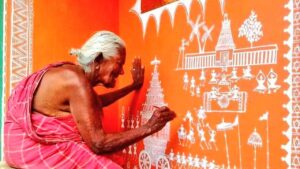A medium that reveals the authentic beauty of any object, nature, or deity is art. It is a pristine expression of how unique creativity can be, and when it comes to traditional art nobody can beat the perfection it holds.
Talking about traditional art my eyes fell in love with this divine, rich and amazing Thanjavur painting also known as Tanjore painting.
This art is exceptional from any other traditional art as each painting is made with a distinct style, vibrant colors, and gold foiling. Eager to learn more about this Tanjore painting? Scroll down to enlighten yourself!!

The roots of Tanjore Painting
Tanjore painting is deep-rooted in history; it was developed in the 16th century by the Chola dynasty. The whole style was later thriven by the Rajus, Nayakas communities, Naidus, and Trichis of Madurai and Maratha princes from the 16th to 18th century.

Flourishing in so many hands, Tanjore painting saw the peak of success only under the regime of Marathas where these paintings were used to embellish the palace and households. And the deserved recognition was perpetuity for this art.
Meaning of Tanjore Painting
So, it’s not just that this traditional art is unique; its features are unique too. It is the anglicized name for Thanjavur Painting. The name Tanjore does not come from any Sanskrit word but a city in South India named Thanjavur which is a core for architecture, art, and religion in the South Indian region.
The Distinctiveness of Tanjore Painting
Tanjore painting is a rich art form that holds distinct features. ‘Palgai Padam’ meaning the wooden plank is what these paintings are made on. Palgai means wooden plank and Padam means picture gives it a unique trait as not many paintings are made on wood.
Gripping the colors that are vibrant and lively, and avoiding the dull colors is what the painting process says. One of the biggest distinguishable attributes of this painting is the golden foils used for embellishing backgrounds, ornaments, or dresses.

Limestone is the substance used as a paste to engrave the precious stones on the wooden plank. Deities like Lord Shiva and Krishna are majorly seen in this style of painting. Lords like Vishnu, Radha Natraja, and others are also painted.
Tanjore painting is one of the art forms that are still popular. Although the quality shows a decline many workshops and training camps retrieve it by flourishing the artform and preserving the richness and tradition it holds.
Also, checkout!!
National Forest Martyrs Day: When Forest Conservation Demanded the Blood of Bishnoi’s




